Pitaya Species and Named
Varieties
At
the present time, there are are large number of named cultivars and
unnamed selections. Many selections have been made and are available in
the US. There are breeding programs in Taiwan, Vietnam, and Israel. In
countries where pitaya are native, selections from the wild are being
used. Many of these have been introduced into countries that are
interested in growing them. Unfortunately, information on the
self-incompatibility of these cultivars and selections is not well
documented. This makes cultivar (variety) recommendations difficult at
best and potentially unreliable.
Species of pitaya
| Species |
Color |
| Peel |
Pulp |
| Hylocereus undatus |
Red |
White |
| Hylocereus triangularis |
Yellow |
White |
| Hylocereus costaricenes |
Red |
Red |
| Hylocereus polyrhizus |
Red |
Red |
| Hylocereus ocamponis |
Red |
Red |
| Selenicereus megalanthus |
Yellow |
White |
| Cereus triangularis |
Yellow |
White |
| Acanthocereus pitajaya |
Yellow |
White |
| Cereus ocamponis |
Red |
Red |
Named varieties
Note: this section was removed from the University of Florida
publication and is only for information purposes.
|
Name1
|
Origin
|
Need for cross pollination
|
Weight (lbs)
|
Peel color
|
Pulp color
|
Flavor
|
Rec.2
|
|
Alice
|
California
|
Yes
|
0.5-1.0
|
Bright pink, green scales
|
White
|
Semisweet, good
|
M
|
|
American Beauty
|
Guatemala |
No
|
0.5-1.0
|
Pink, light green scales
|
Dark pink
|
Good flavor
|
Y
|
|
Bloody Mary
|
California
|
Yes
|
0.25-0.5
|
Red, green scales
|
Dark red
|
Semisweet, good
|
N
|
|
Cosmic Charlie
|
California
|
No
|
0.75-1.25
|
Pink, light green scales
|
Pink
|
Grape/kiwi-
like flavor
|
Y
|
|
Costa Rican Sunset
|
Costa Rica |
Yes
|
0.25-0.5
|
Pink, green scales
|
Dark red
|
Good flavor
|
M
|
|
Dark Star
|
California
|
No
|
0.75-1.25
|
Pink, light green scales
|
Pink
|
Mild grape-like flavor
|
Y
|
|
David Bowie
|
California
|
No
|
0.5-1.0
|
Bright pink, green on margins of scales
|
White
|
Sweet, tangy flavor
|
Y
|
|
Delight
|
California
|
No
|
0.5-1.0
|
Bright pink, green scales
|
White
|
Sweet
|
Y
|
|
Guyute
|
Central America |
No
|
0.5-1.0
|
Pink, green scales
|
White
|
Sweet
|
Y
|
|
Halleys Comet
|
California
|
No
|
1.5-2.0
|
Pink, green scales
|
Dark pink
|
Sweet, good flavor
|
Y
|
|
Harpua
|
Central America |
No
|
0.75-1.0
|
Bright pink, green scales
|
White
|
Semisweet, good flavor
|
M
|
|
L.A. Women
|
California
|
Yes
|
0.75-1.5
|
Bright pink, green scales
|
White
|
Sweet, bad after taste
|
N (bad aftertaste)
|
|
Lake Atitlan
|
Guatemala |
No
|
0.75-1.0
|
Bright pink, green scales
|
White
|
Sweet and tangy flavor
|
M
|
|
Makisupa
|
Central America |
No
|
0.75-1.0
|
Pink, green scales
|
Dark Pink
|
Sweet, slightly astringent
|
Y
|
|
Neitzl
|
California
|
No
|
0.75-1.0
|
Bright pink, green scales
|
White
|
Sweet
|
Y
|
|
Physical Graffiti
|
California
|
No
|
0.75-1.5
|
Dark pink, green scales
|
Pink
|
Sweet, good flavor
|
Y
|
|
Purple Haze
|
California
|
No
|
1.0-2.0
|
Dark pink, green scales
|
Dark pink
|
Sweet grape/kiwi- like flavor
|
Y
|
|
Red Jaina
|
Florida
|
Yes
|
0.5-0.75
|
Dark pink, dark pink scales
|
Red
|
Semisweet, good flavor
|
N
|
|
Seoul Kitchen
|
Florida
|
No
|
0.75-1.0
|
Bright pink, light green scales
|
White
|
Sweet
|
Y
|
|
Thompson
|
California
|
No
|
0.75-1.5
|
Bright pink, green scales
|
White
|
Sweet, good flavor
|
Y
|
|
Vietnam Jaina
|
Vietnam
|
No
|
0.5-1.5
|
Bright pink, green scales
|
White
|
Semisweet
|
Y
|
|
Voodoo Child
|
Florida
|
No
|
0.15-0.25
|
Dark pink, green scales
|
Dark pink
|
Sweet, grape-like flavor
|
M
|
|
Yellow Dragon
|
Florida
|
No
|
0.5-0.75
|
Bright yellow, green tinged scales
|
White
|
Sweet, very good flavor
|
Y
|
|
Zamorano
|
Honduras
|
No
|
0.5-1.0
|
Red, scales with green margins
|
Red
|
Sweet, mild flavor
|
Y
|
1 Selected and named in
Florida.
2 Recommendation for planting in the
home landscape; Y, yes; M, maybe; and N, no.
|
 |
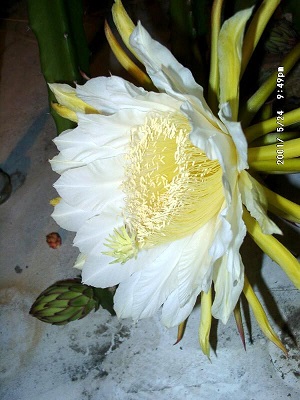 |
 |
 |
Fig.
1 
H.
undatus
White-fleshed pitahaya
|
Fig.
2 
H.
costaricensis
Red fleshed pitahaya |
Fig.
3 
H.
megalanthus
Yellow Pitahaya
|
Fig.
4 
H. triangularis
|
H. undatus
(Pitaya blanca or white-fleshed pitahaya) has pink-skinned fruit with
white flesh. This is the most commonly seen "dragon fruit".
H. costaricensis
(Pitaya roja or red-fleshed pitahaya, also known as H. polyrhizus) has
red-skinned fruit with red flesh.
H. megalanthus
(Pitaya amarilla or yellow pitahaya, also known as Selenicereus megalanthus)
has yellow-skinned fruit with white flesh.
 |
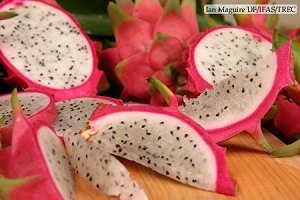 |
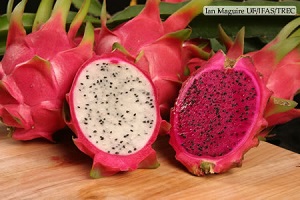 |
Fig.
5 
Red flesh dragon fruit
H.
costaricenes |
Fig.
6 
White flesh dragon fruit
H. undatus |
Fig.
7 
Comparing white and red varieties
|
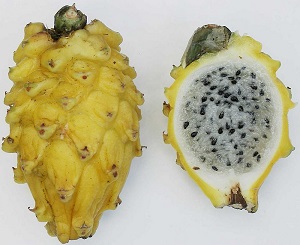
Fig. 8 
Yellow pitaya
H. megalanthus
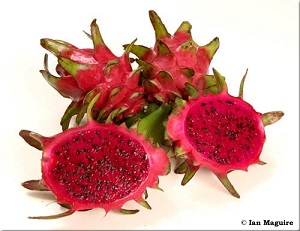 |
 |
Fig.
9 
'Bloody Mary'
H. polyrhizus |
Fig.
10 
'Costa Rica Sunset'
H.
spp. |
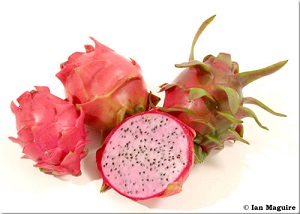 |
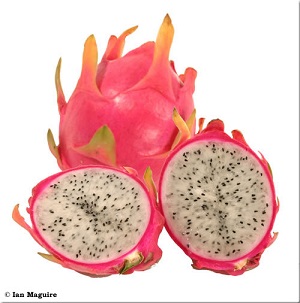 |
Fig.
11 
'Delight'
H. polyrhizus
x undatus |
Fig.
12 
'Seoul Kitchen'
H. undatus |
Further Reading
Pitaya, Hylocereous undatus
(Haw) - A Potential New Crop for Australia, Archives of the
Rare Fruit Council of Australia
Back to
Pitaya Page
|
Bibliography
Crane, Johathan H., et al. "Pitaya Growing in
the florida Home Landscape." Horticultural Sciences Dept.,
UF/IFAS Extension, HS1068, Original Pub.
Nov. 2005, Revised Nov. 2016, and Dec. 2019, AskIFAS, edis.ifas.ufl.edu/HS303. Accessed
17 June 2017, 17 Mar. 2021.
Photographs
Fig. 1 Eliasson, Ulf. 'Hylocereus undatus."
Wikimedia Commons,
2003, (CC
BY 2.5), commons.wikimedia.org. Accessed 20 June 2017.
Fig. 2 Edward. "Hylocereus costaricensis."
Wikipedia,
2005, wikipedia.org. Accessed
20 June 2017.
Fig. 3 Edward. "Hylocereus megalanthus." Wikipedia,
2000, Public Domain, wikipedia.org.
Accessed 20 June 2017.
Fig. 4 Hoyer, Richard C. "Hylocereus triangularis." Wikimedia Commons,
2009, Public domain, (CC BY 3.0), commons.wikimedia.org. Accessed 20 June 2017.
Fig. 5,6,7,9,10,11,12 Maguire, Ian.
"Dragon fruit." Tropical
Fruit Photography Picture Archive, 2011, trec.ifas.ufl.edu. Accessed
24 March. 2014.
Fig. 8 Fibonacci. "Hylocereus megalanthus, Yellow
pitahaya fruit with spines removed." Wikipedia, 2006, (CC BY-SA 3.0),
wikipedia.org.
Accessed
20 June 2017.
Published 24 March. 2014 LR. Last update 17 Mar. 2021 LR
|












